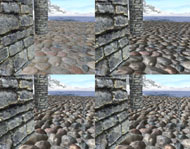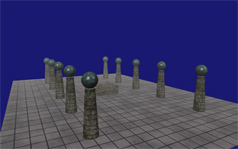Articles and Code

Sprites and Text: Unlike previous versions of Direct3D, Direct3D 11 does not have a utility library for drawing sprites and fonts. This samples shows one strategy for drawing sprites and fonts.

Parallax Occlusion Mapping: Introduction to 3D Game Programming with DirectX 11 has a chapter explaining normal mapping and displacement mapping (implemented with hardware tessellation). We saw that we could improve upon normal mapping by tessellating the geometry and displacing it with a heightmap to geometrically model the bumps and crevices of the surface. However, an application may be required to support DirectX 10 for systems that do not have DirectX 11 capable hardware; therefore, we need a fallback technique for when we do not have access to hardware tessellation. Parallax Occlusion Mapping is a technique that gives results similar to tessellation displacement mapping, and can be implemented in DirectX 10
- Controls:
- Hold the left mouse button down and move the mouse to rotate.
- Hold the right mouse button down to zoom in and out.
- Press '1' for wireframe
- Press '2' for BasicFX
- Press '3' for Normal mapping
- Press '4' for Parallax Occlusion mapping
- Press '5' for Displacement mapping
- Press 'F' to increase heights
- Press 'G' to decrease heights

Win8 Metro and Direct3D: Win8 Metro styled applications cannot use the Effects framework or the D3DX library. This sample shows how to modify the book's code to get the samples running under Win8 as Metro styled applications. In particular, it shows how to:
- create, update, and set constant buffers without the Effects framework.
- load textures using a Win8 Metro friendly texture loading library provided by Microsoft.
- create and set sampler-state objects.
- create shader permutations with conditional compilation.

